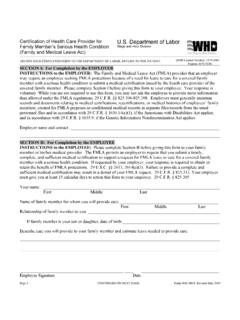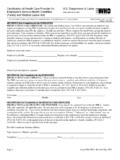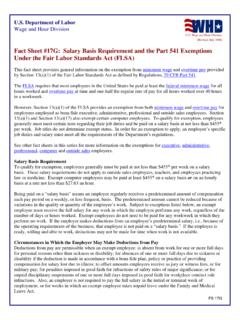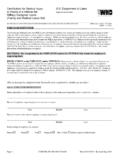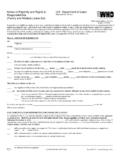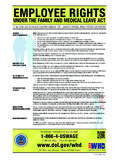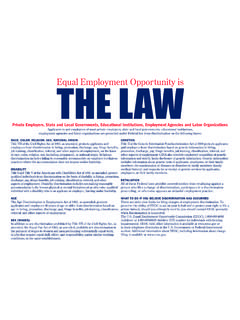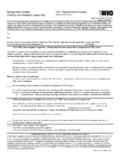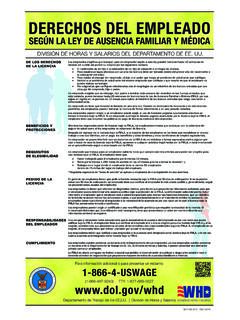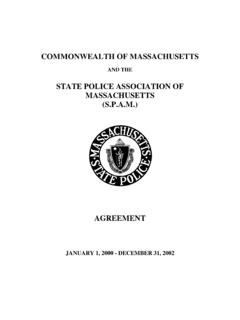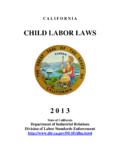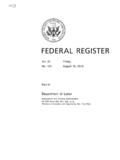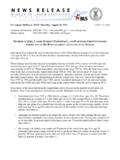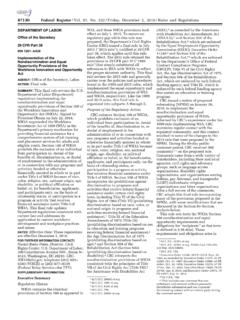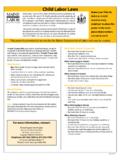Transcription of U.S. Department of Labor Wage and Hour Division
1 Department of Labor Wage and Hour Division (July 2008) Fact Sheet #13: employment relationship Under the Fair Labor Standards Act (FLSA) This fact sheet provides general information concerning the meaning of " employment relationship " and the significance of that determination in applying provisions of the FLSA. Characteristics An employment relationship under the FLSA must be distinguished from a strictly contractual one. Such a relationship must exist for any provision of the FLSA to apply to any person engaged in work which may otherwise be subject to the Act. In the application of the FLSA an employee, as distinguished from a person who is engaged in a business of his or her own, is one who, as a matter of economic reality, follows the usual path of an employee and is dependent on the business which he or she serves. The employer-employee relationship under the FLSA is tested by "economic reality" rather than "technical concepts." It is not determined by the common law standards relating to master and servant.
2 The Supreme Court has on a number of occasions indicated that there is no single rule or test for determining whether an individual is an independent contractor or an employee for purposes of the FLSA. The Court has held that it is the total activity or situation which controls. Among the factors which the Court has considered significant are: 1) The extent to which the services rendered are an integral part of the principal's ) The permanency of the ) The amount of the alleged contractor's investment in facilities and ) The nature and degree of control by the ) The alleged contractor's opportunities for profit and ) The amount of initiative, judgment, or foresight in open market competition with others required for thesuccess of the claimed independent ) The degree of independent business organization and are certain factors which are immaterial in determining whether there is an employment relationship . Such facts as the place where work is performed, the absence of a formal employment agreement, or whether an alleged independent contractor is licensed by State/local government are not considered to have a bearing on determinations as to whether there is an employment relationship .
3 Additionally, the Supreme Court has held that the time or mode of pay does not control the determination of employee status. Requirements When it has been determined that an employer-employee relationship does exist, and the employee is engaged in work that is subject to the Act, it is required that the employee be paid at least the Federal minimum wage of $ per hour effective July 24, 2007; $ per hour effective July 24, 2008; and $ per hour effective July 24, 2009, and in most cases overtime at time and one-half his/her regular rate of pay for all hours worked in FS 13excess of 40 per week. T he Act also has youth employment provisions which regulate the employment of minors under the age of ei ght een, as well as recordkeeping requirements. Typical Problems (1) One of the most common problems is in the construction industry where contractors hire so-calledindependent contractors, who in reality should be considered employees because they do not meet the tests forindependence, as stated above.
4 (2) Franchise arrangements can pose problems in this area as well . Dependingon t he level of cont rol the franchisor has over the franchisee, employees of t he latter may be considered to beemployed by the franchisor. (3) A situati on involving a person volunteering his or her services for another mayalso result in an employment relationship . For example, a person who is an employee cannot "volunteer" his/herservices to the employer to perform the same type service performed as an employee. Of course, individualsmay volunteer or donat e their services to religious, public service, and non-profit organizations, withoutcontemplation of pay, and not be considered employees of such organization. (4) Trainees or students may alsobe employees, depending on the circumstances of their activities for the employer. (5) People who performwork at their own home are often improperly considered as in dependent contractors. The Act covers suchhomeworkers as employees and t hey are entitled to al l be nefits of t h e to Obtain Additional Information For additional information, visit our Wage and Hour Division Website: and/or call our toll-free information and helpline, available 8 to 5 in your time zone, 1-866-4 USWAGE (1-866-487-9243).
5 This publication is for general information and is not to be considered in the same light as official statements of position contained in the regulations. Department of Labor Frances Perkins Building 200 Constitution Avenue, NW Washington, DC 20210 1-866-4-USWAGE TTY: 1-866-487-9243 Contact Us
